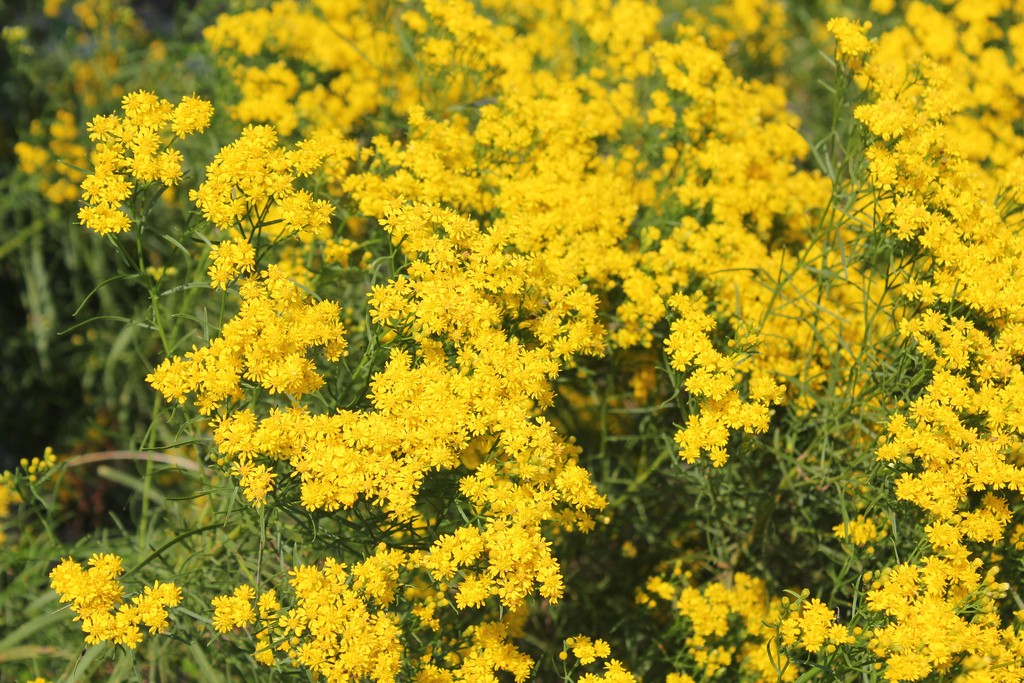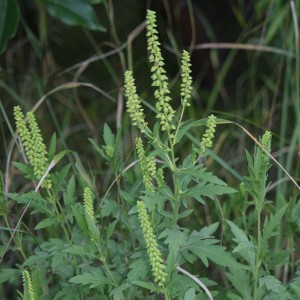Goldenrod takes a bum rap for its cousin ragweed

Goldenrod gets all the attention. . . Photo: Azucena Ponce, U.S. Fish & Wildlife Service
While most plants respond to late summer’s shorter days by starting to wind down their business for the season, goldenrod is a “short-day” plant, the kind that is stimulated to bloom by waning day length. It’s a perennial in the aster family, and is widespread across North America. We have something on the order of 130 species of goldenrod in the genus Solidago.
As one of the most abundant blooms of autumn, this native wildflower is for many insects, including numerous bee species, a vital source of nectar as well as of nutritious pollen. Unfortunately, this latter item has given goldenrod a black eye among many allergy sufferers.
Goldenrod’s showy yellow flowers are in full view along roadsides and in meadows and pastures just about the time fall hay fever season usually kicks in. So it’s understandable that goldenrod has been blamed for the red itchy eyes, sinus congestion, sneezing, and general histamine-soaked misery that some folks experience this time of year. But it turns out that goldenrod pollen is innocent of all charges.
Goldenrod can’t be guilty because its pollen is quite heavy. That’s a relative term, I suppose, since it’s light enough that bees manage to carry a great deal of it away. But in the pollen realm it’s heavy—and also very sticky—and it doesn’t blow far from the plant. It’s not that goldenrod pollen is incapable of eliciting an allergic response, it’s just that to do so, one would have to literally stick its pollen in one’s nose and snuff it up.
Not only is goldenrod guiltless of allergic assault, it has been used as an alternate source of rubber. Henry Ford was intrigued by goldenrod, and reportedly produced some tires made from the plant. Interest in goldenrod was revived during World War II. Goldenrod is also used in herbal medicine to help treat kidney stones, sore throats and toothaches.

But it’s quiet cousin ragweed that does all the mischief. Photo: Krzysztof Ziarnek Kenraiz, Creative Commons, some rights reserved
So who’s to blame for the spike in late summer allergies? Surprisingly, the culprit is goldenrod’s cousin, ragweed, although it doesn’t behave at all like its golden relative (I suspect we all have a relative or two like this in our family tree). Ragweed, a native plant, is also in the aster family, but unlike goldenrod it churns out loads of very light pollen.
Just how light is it? Ragweed pollen can remain airborne for several days, and significant quantities have been found as far as 400 miles out to sea. And a single ragweed plant can produce a billion pollen grains to fly on the breeze and make you sneeze. Yep, this is the stuff that stuffs you up.
One reason we don’t suspect ragweed is that its blossoms are dull green and look nothing like a typical flower. It’s as if they’re trying not to attract attention. You can almost imagine them thinking, “heh, heh—let goldenrod take the rap.” The reason ragweed is inconspicuous is that it’s wind pollinated and has no need to “advertise” with bright colors and sweet nectar to attract pollinators.
Most ragweed species—there are about 50 of them—are annual, and come back from the copious seeds produced each fall. Ragweed will keep billowing allergens until the first hard frost, so let’s hope it’s not too much of an extended season this year. And let’s try to spread the word about goldenrod to spare it any further false accusations.
Paul Hetzler is a horticulture and natural resources educator with Cornell Cooperative Extension of St. Lawrence County.








Ragweed used to be non-existent in the Lake Placid area of the central Adirondacks, and folks vacationed here in part to escape the allergy attacks associated with late summer’s ragweed bloom further south. But in recent (last 10?) years, coinciding with (and because of?) our warming climate, ragweed has proliferated along all our local roadsides and seems here to stay. We have managed to keep the plants off our 135-ac preserve but doing so requires annual vigilance and the pollen is still omnipresent.
As far as I know, the only thing I am allergic to is poverty. Poverty sucks. Oh, and if it gets too warm, I’m allergic to that.
I like all plants and animals. I even like human animals.